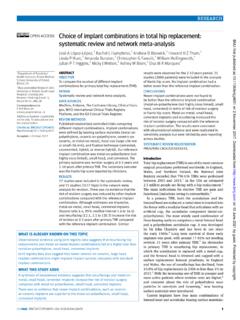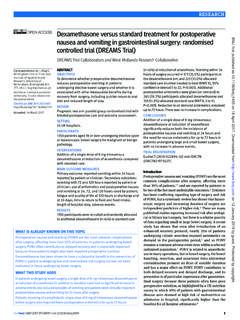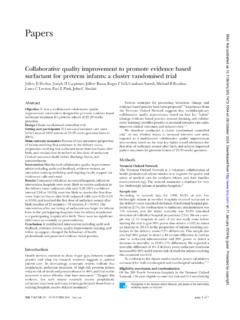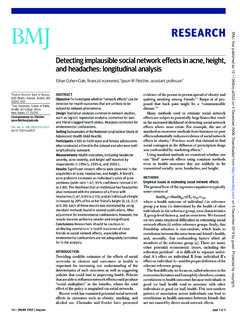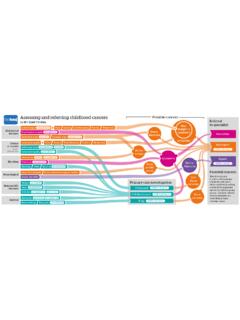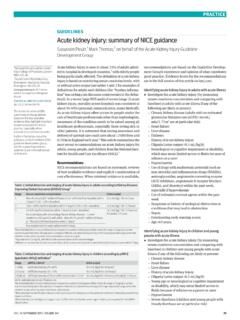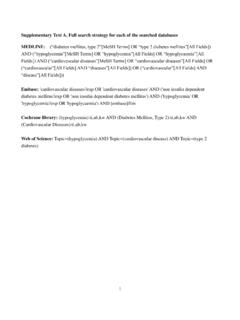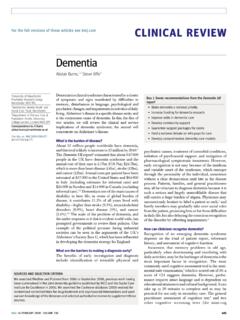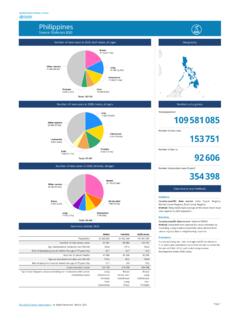Transcription of Association between age at onset of multimorbidity and ...
1 RESEARCH. Association between age at onset of multimorbidity and BMJ: first published as on 2 February 2022. Downloaded from on 11 April 2022 by guest. Protected by copyright. incidence of dementia: 30 year follow-up in Whitehall II. prospective cohort study C line Ben Hassen,1 Aurore Fayosse,1 Benjamin Landr ,1 Martina Raggi,1 Mikaela Bloomberg,1,2. S verine Sabia,1,2 Archana Singh-Manoux1,2. 1. Universit de Paris, Inserm ABSTRACT age at onset of multimorbidity . At age 65, onset of U1153, Epidemiology of OBJECTIVE multimorbidity before age 55 was associated with Ageing and Neurodegenerative To examine the Association of midlife and late life ( to ) per 1000 person years higher Diseases, Paris, France 2 multimorbidity , including severity of multimorbidity , incidence of dementia (hazard ratio , to Department of Epidemiology and Public Health, University with incident dementia.)
2 And onset between 60 and 65 was associated College London, London, UK DESIGN with ( to ) per 1000 person years Correspondence to: Prospective cohort study. higher incidence ( , to ). Severity of C Ben Hassen multimorbidity ( 3 chronic diseases) at age 55 was SETTING. (or @epiAgeing on Twitter; associated with a ( to ) per 1000. Civil service departments in London (Whitehall II. ORCID 0000-0001-7884-2986) person years higher incidence of dementia (hazard study, study inception in 1985-88). Additional material is published ratio , to ); the same analyses at age online only. To view please visit PARTICIPANTS 70 showed ( to ) per 1000 person years the journal online.
3 10 095 participants, aged 35 to 55 at baseline. higher incidence ( , to ). Cite this as: BMJ 2022;376:e068005. MAIN OUTCOME MEASURE CONCLUSION. bmj 2021 068005 Incident dementia at follow-up between 1985 and multimorbidity , particularly when onset is in midlife Accepted: 15 December 2021. 2019. Cause specific Cox proportional hazards rather than late life, has a robust Association with regression was used to examine the Association of subsequent dementia. The increasingly younger multimorbidity overall and at age 55, 60, 65, and 70 age at onset of multimorbidity makes prevention of with subsequent dementia, taking into account the multimorbidity in people with a first chronic disease competing risk of death.
4 Important. RESULTS. The prevalence of multimorbidity ( 2 chronic Introduction diseases) was (655/9937) at age 55 and Increase in human life expectancy over the past two (2464/7783) at age 70; 639 cases of incident centuries implies that adults commonly live to age 65. dementia occurred over a median follow-up of and beyond, particularly in high income countries . A. years. After adjustment for sociodemographic factors major consequence of the ageing of the population is and health behaviours, multimorbidity at age 55 the growing prevalence of dementia, which increases was associated with subsequent risk of dementia markedly after age Alzheimer's disease, the (difference in incidence rate per 1000 person years primary cause of dementia, is a complex, multisystemic , 95% confidence interval to ; hazard disease for which an effective cure remains elusive.)
5 As ratio , 95% confidence interval to ). the pathophysiological process underlying Alzheimer's The Association weakened progressively with older disease and related dementias unfolds over several decades,2 interest is increasing in how risk factors over the life course, including chronic diseases, shape the WHAT IS ALREADY KNOWN ON THIS TOPIC risk of dementia at older Robust evidence shows that multimorbidity is highly prevalent, particularly at A further consequence of population ageing is the older ages and in people living with dementia increase in multimorbidity ,4-6 conventionally defined Most studies on the Association between multimorbidity and dementia are as the presence of two or more chronic diseases cross sectional, and the few prospective studies have a short follow-up with irrespective of the severity of such conditions.
6 Recent multimorbidity measured only at older ages estimates suggest that more than 50% of older adults Studies that examine whether earlier age at onset of multimorbidity affects the in high income countries report multiple chronic conditions, although multimorbidity is not confined to risk of subsequent dementia are lacking older 5 The development of chronic diseases at WHAT THE STUDY ADDS younger ages has implications for their management, multimorbidity , defined as co-occurrence of two or more chronic conditions, was the risk of premature mortality, and the cost of associated with a increase in risk of dementia over a median follow-up multimorbidity is estimated to have an adverse effect of 32 years on patients' outcomes and healthcare systems that For every 5 year younger age at onset of multimorbidity up to age 70, the risk of is greater than that of chronic conditions considered dementia was higher by 18%.
7 In older adults with dementia, the presence of several Increased severity of multimorbidity strengthened associations with dementia, comorbid conditions is 10 A recent study of particularly multimorbidity in midlife older adults (mean age 75 years) followed for a mean the bmj | BMJ 2022;376:e068005 | doi: 1. RESEARCH. of years reported higher risk of dementia in those electrocardiogram recording), stroke (ICD10: I60-I64, BMJ: first published as on 2 February 2022. Downloaded from on 11 April 2022 by guest. Protected by copyright. with multimorbidity ,11 but studies that have followed MONICA-Ausburg stroke questionnaire), heart failure individuals for longer are lacking.
8 Recent studies also (ICD10: I50), diabetes (ICD10: E10-E14, reported suggest that the risk of dementia is higher in people diabetes diagnosed by a doctor, use of diabetes with cardiometabolic disease in midlife rather than late drugs, or fasting glucose mmol/L), hypertension life,12 13 suggesting that age at onset of multimorbidity (ICD10: I10-I16, systolic blood pressure 140 mm is an important determinant of risk of dementia. Hg, diastolic blood pressure 90 mm Hg, or use of Accordingly, we examined whether longer duration of antihypertensive drugs), cancer (malignant neoplasms multimorbidity and severity of multimorbidity (defined ICD10: C00-C97), chronic kidney disease (ICD10: as three or more chronic conditions), implying earlier N18), chronic obstructive pulmonary disease (ICD10: age at onset of multimorbidity , increase the risk of J41-J44), liver disease (toxic liver disease, alcoholic dementia at older ages in a study spanning 30 years.)
9 Liver disease, inflammatory liver disease, chronic The main focus was on any multimorbidity , but in hepatis, hepatic failure, fibrosis and cirrhosis, other exploratory analyses we also examined the importance diseases of liver, ICD10: K70-K74), depression (ICD10: of chronic disease dyads and their associations with F32-F33, use of antidepressants), mental disorders dementia. Besides dementia, the primary outcome, other than depression (ICD codes: F06, other mental we examined the role of age at onset of multimorbidity disorders due to known physiological condition; F07: and subsequent mortality. personality and behavioural disorders due to known physiological condition; F09: unspecified mental Methods disorder due to known physiological condition.
10 The ongoing Whitehall II cohort study was established F20-F48 (excluding F32: depressive episode and F33: in 1985-88 among 10 308 employees (6895 men major depressive disorder, recurrent): mood/affective and 3413 women) of the British civil service, based disorders, schizophrenia, schizotypal, delusional, in London at recruitment to the study and aged 35- and other non-mood psychotic disorders, anxiety, 55 Follow-up clinical examinations have dissociative, stress related, somatoform and other taken place approximately every four to five years nonpsychotic mental disorders; and F60-69 (excluding since baseline (1991-93, 1997-99, 2002-04, 2007- F65: paraphilias and F66: other sexual disorders): 09, 2012-13, 2015-16, and an ongoing wave).


